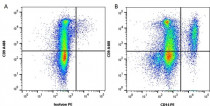ARG22942
anti-CD14 antibody [TÜK4] (PE)
anti-CD14 antibody [TÜK4] (PE) for Flow cytometry and Human,Bovine,Cat,Dog,Goat,Pig,Rabbit,Sheep
Developmental Biology antibody; Immune System antibody; General Lymphocyte Marker Study antibody; Macrophages and neutrophils antibody
Overview
| Product Description | PE-conjugated Mouse Monoclonal antibody [TÜK4] recognizes CD14 Mouse anti human CD14 antibody, clone TÜK4 recognizes the human CD14 cell surface antigen. CD14 is a 55 KDa glycoprotein that contains multiple leucin-rich repeats. It is anchored to the cell membrane via a glycosylphosphatidylinositol (GPI) linkage (Simmons et al. 1989) but a soluble form of CD14 also exists (Bazil et al. 1986).CD14 is strongly expressed on the surface of monocytes and macrophages but has also been shown to be expressed on the surface of non-myeloid cells (Jersmann 2005). CD14 functions as a pattern recognition receptor (Pugin et al. 1994, Dziarski et al. 1998) in innate immunity for a variety of ligands, in particular for the LPS (endotoxin) of Gram-negative bacteria.Mouse anti human CD14 antibody, clone TÜK4 has been shown to block SDF-induced chemotaxis of U937 cells in a dose âdependent manner (Yang et al. 2003). Arigo recommend the use of the anti-human CD14 antibody, Low Endotoxin format for this purpose. |
|---|---|
| Tested Reactivity | Hu, Bov, Cat, Dog, Goat, Pig, Rb, Sheep |
| Tested Application | FACS |
| Host | Mouse |
| Clonality | Monoclonal |
| Clone | TÜK4 |
| Isotype | IgG2a |
| Target Name | CD14 |
| Antigen Species | Human |
| Conjugation | PE |
| Alternate Names | CD antigen CD14; Myeloid cell-specific leucine-rich glycoprotein; Monocyte differentiation antigen CD14 |
Application Instructions
| Application Suggestion |
|
||||
|---|---|---|---|---|---|
| Application Note | FACS: Use 5ul of the suggested working dilution to label 10^6 cells or 100 µl whole blood. * The dilutions indicate recommended starting dilutions and the optimal dilutions or concentrations should be determined by the scientist. |
Properties
| Form | Liquid |
|---|---|
| Purification | Purification with Protein A. |
| Buffer | PBS, 0.09% Sodium azide, 1% BSA and 5% Sucrose |
| Preservative | 0.09% Sodium azide |
| Stabilizer | 1% BSA and 5% Sucrose |
| Storage Instruction | Aliquot and store in the dark at 2-8°C. Keep protected from prolonged exposure to light. Avoid repeated freeze/thaw cycles. Suggest spin the vial prior to opening. The antibody solution should be gently mixed before use. |
| Note | For laboratory research only, not for drug, diagnostic or other use. |
Bioinformation
| Database Links | |
|---|---|
| Gene Symbol | CD14 |
| Gene Full Name | CD14 molecule |
| Background | The protein encoded by this gene is a surface antigen that is preferentially expressed on monocytes/macrophages. It cooperates with other proteins to mediate the innate immune response to bacterial lipopolysaccharide. Alternative splicing results in multiple transcript variants encoding the same protein. [provided by RefSeq, Mar 2010] |
| Function | In concert with LBP, binds to monomeric lipopolysaccharide and delivers it to the MD-2/TLR4 complex, thereby mediating the innate immune response to bacterial lipopolysaccharide (LPS). Acts via MyD88, TIRAP and TRAF6, leading to NF-kappa-B activation, cytokine secretion and the inflammatory response. Up-regulates cell surface molecules, including adhesion molecules. [UniProt] |
| Research Area | Developmental Biology antibody; Immune System antibody; General Lymphocyte Marker Study antibody; Macrophages and neutrophils antibody |
| Calculated MW | 40 kDa |
| PTM | N- and O- glycosylated. O-glycosylated with a core 1 or possibly core 8 glycan. |
Images (1) Click the Picture to Zoom In
-
ARG22942 anti-CD14 antibody [TÜK4] (PE) FACS image
Flow Cytometry: Figure A. Alexa Fluor488 conjugated mouse anti Human CD9 and PE-conjugated mouse IgG2a isotype control. Figure B. Alexa Fluor488 conjugated mouse anti Human CD9 and ARG22942 anti-CD14 antibody [TÜK4] (PE). All experiments performed on red cell lysed Human blood gated on myeloid cells.






